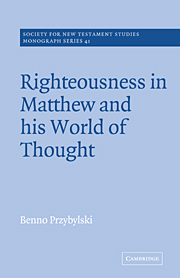Book contents
- Frontmatter
- Contents
- Preface
- Abbreviations
- 1 The problem of the meaning and significance of the Matthaean concept of righteousness
- 2 Tsedeq, tsedaqah and tsaddiq in the Dead Sea Scrolls
- 3 Tsedeq, tsedaqah and tsaddiq in the Tannaitic literature
- 4 The meaning of dikaiosynē, eleēmosynē and dikaios in the Gospel of Matthew
- 5 The relative significance of the concept of righteousness in the Gospel of Matthew
- 6 The provisional function of the Matthaean concept of righteousness
- Notes
- Bibliography and system of references
- Index of passages cited
- General index
3 - Tsedeq, tsedaqah and tsaddiq in the Tannaitic literature
Published online by Cambridge University Press: 18 December 2009
- Frontmatter
- Contents
- Preface
- Abbreviations
- 1 The problem of the meaning and significance of the Matthaean concept of righteousness
- 2 Tsedeq, tsedaqah and tsaddiq in the Dead Sea Scrolls
- 3 Tsedeq, tsedaqah and tsaddiq in the Tannaitic literature
- 4 The meaning of dikaiosynē, eleēmosynē and dikaios in the Gospel of Matthew
- 5 The relative significance of the concept of righteousness in the Gospel of Matthew
- 6 The provisional function of the Matthaean concept of righteousness
- Notes
- Bibliography and system of references
- Index of passages cited
- General index
Summary
Introduction
In the discussion concerning the method of the present study the general rationale behind the treatment of the Tannaitic literature was outlined. Before turning to the analysis of the terms tsedeq, tsedaqah and tsaddiq it is, however, necessary to deal specifically with the nature of this literature.
The Tannaitic period is generally defined as spanning A.D. 10 to A.D. 220, that is, beginning with the disciples of Shammai and Hillel and ending with the contemporaries of R. Judah ha-Nasi. The Rabbis who lived during this period are known as the Tannaim and their sayings and discussions form the Tannaitic literature.
The Tannaitic literature has been preserved in two distinct forms. In the mishnaic form the materials are arranged according to topical criteria, while in the midrashic form the materials follow the sequence of the biblical book which is commented upon. Both types of writings are primarily halakic rather than haggadic in content.
The Tannaitic literature of the mishnaic form consists of the Mishnah, Tosefta and various traditions in the Palestinian and Babylonian Talmuds which are attributed to Tannaim. The latter sayings are generally referred to as baraitot. The Tannaitic literature of the midrashic form consists of the halakic midrashim such as the Mekilta on Exodus, Sifra on Leviticus, Sifre on Numbers and Deuteronomy, Sifre Zuta on Numbers, Mekilta of R. Simeon b. Yohai on Exodus, Midrash Tannaim on Deuteronomy and baraitot in later midrashim such as Midrash Rabbah.
- Type
- Chapter
- Information
- Righteousness in Matthew and his World of Thought , pp. 39 - 76Publisher: Cambridge University PressPrint publication year: 1981



